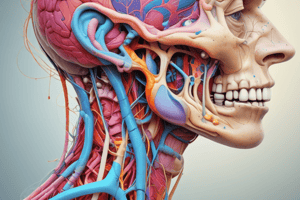Podcast
Questions and Answers
Which nerve is associated with the 1st pharyngeal arch?
Which nerve is associated with the 1st pharyngeal arch?
- CN V (correct)
- CN VII
- CN X
- CN IX
What muscle is NOT derived from the 2nd pharyngeal arch?
What muscle is NOT derived from the 2nd pharyngeal arch?
- Masseter (correct)
- Stylohyoid
- Stapedius
- Platysma
Which of the following cartilages is associated with the 3rd pharyngeal arch?
Which of the following cartilages is associated with the 3rd pharyngeal arch?
- Greater horn of hyoid (correct)
- Stapes
- Thyroid
- Arytenoids
Which muscle is associated with the fourth pharyngeal arch?
Which muscle is associated with the fourth pharyngeal arch?
Which cranial nerve is linked to swallowing and is associated with the 3rd pharyngeal arch?
Which cranial nerve is linked to swallowing and is associated with the 3rd pharyngeal arch?
Which of the following cartilages is NOT derived from the 4th and 6th pharyngeal arches?
Which of the following cartilages is NOT derived from the 4th and 6th pharyngeal arches?
Which muscle is included in the derivatives of the 1st pharyngeal arch?
Which muscle is included in the derivatives of the 1st pharyngeal arch?
What is the primary nerve for the 2nd pharyngeal arch?
What is the primary nerve for the 2nd pharyngeal arch?
Which joint feature is derived from the 4th pharyngeal arch derivatives?
Which joint feature is derived from the 4th pharyngeal arch derivatives?
Which of the following structures is a derivative of the 2nd pharyngeal arch?
Which of the following structures is a derivative of the 2nd pharyngeal arch?
Flashcards are hidden until you start studying
Study Notes
First Pharyngeal Arch
- Nerve: Cranial Nerve V (Trigeminal) - Responsible for chewing.
- Muscles: Muscles of mastication (temporalis, masseter, lateral and medial pterygoids, mylohyoid, anterior belly of digastric, tensor tympani), anterior two-thirds of tongue, tensor veli palatini.
- Cartilage: Maxillary process (maxilla, zygomatic bone), Mandibular process (mandible).
Second Pharyngeal Arch
- Nerve: Cranial Nerve VII (Facial) - Responsible for facial expressions.
- Muscles: Muscles of facial expression (stapedius, stylohyoid, platysma, posterior belly of digastric).
- Cartilage: Reichert's cartilage (stapes, styloid process, lesser horn of hyoid, stylohyoid ligament).
Third Pharyngeal Arch
- Nerve: Cranial Nerve IX (Glossopharyngeal) - Helps with swallowing.
- Muscles: Stylopharyngeus.
- Cartilage: Greater horn of hyoid.
Fourth and Sixth Pharyngeal Arches
- Nerve: Cranial Nerve X (Vagus) - Superior laryngeal branch and recurrent/inferior laryngeal branch.
- Muscles:
- Fourth Arch: Most pharyngeal constrictors, cricothyroid, levator veli palatini
- Sixth Arch: All intrinsic muscles of the larynx except cricothyroid.
- Cartilage: Arytenoids, cricoid, corniculate, cuneiform, thyroid - These cartilages are crucial for speech and singing.
Studying That Suits You
Use AI to generate personalized quizzes and flashcards to suit your learning preferences.



